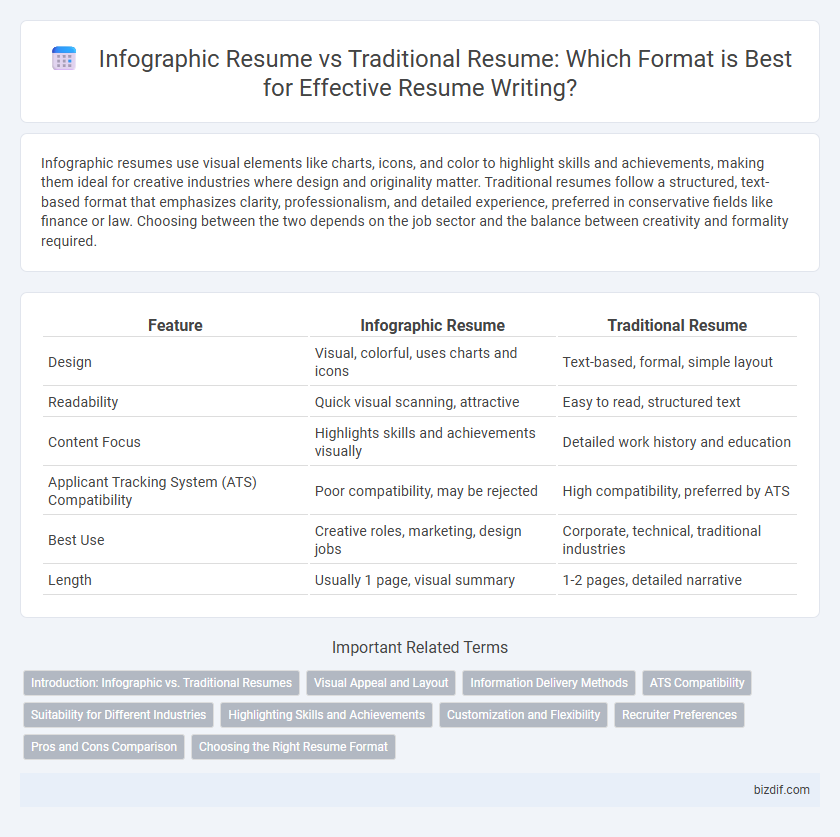Infographic resumes use visual elements like charts, icons, and color to highlight skills and achievements, making them ideal for creative industries where design and originality matter. Traditional resumes follow a structured, text-based format that emphasizes clarity, professionalism, and detailed experience, preferred in conservative fields like finance or law. Choosing between the two depends on the job sector and the balance between creativity and formality required.
Table of Comparison
| Feature | Infographic Resume | Traditional Resume |
|---|---|---|
| Design | Visual, colorful, uses charts and icons | Text-based, formal, simple layout |
| Readability | Quick visual scanning, attractive | Easy to read, structured text |
| Content Focus | Highlights skills and achievements visually | Detailed work history and education |
| Applicant Tracking System (ATS) Compatibility | Poor compatibility, may be rejected | High compatibility, preferred by ATS |
| Best Use | Creative roles, marketing, design jobs | Corporate, technical, traditional industries |
| Length | Usually 1 page, visual summary | 1-2 pages, detailed narrative |
Introduction: Infographic vs. Traditional Resumes
Infographic resumes leverage visual elements such as charts, icons, and color schemes to present skills and experience clearly and memorably, enhancing quick comprehension by recruiters. Traditional resumes rely on text-based formats that emphasize detailed descriptions and chronological work history, appealing to applicant tracking systems (ATS) for seamless parsing. Choosing between infographic and traditional resumes depends on industry norms, job role, and the balance between visual appeal and ATS compatibility.
Visual Appeal and Layout
Infographic resumes leverage vibrant colors, icons, and charts to create a visually engaging layout that captures attention quickly, enhancing readability and information retention. Traditional resumes follow a more structured, text-based format with clear headings and bullet points, prioritizing simplicity and professional appearance. The visual appeal of infographic resumes can differentiate candidates, while traditional resumes ensure clarity and ease of scanning by applicant tracking systems (ATS).
Information Delivery Methods
Infographic resumes use visual elements like icons, charts, and graphics to present information quickly and engage viewers, making them ideal for creative industries. Traditional resumes rely on structured text and bullet points, emphasizing clarity and detailed content suitable for conventional roles. Each method caters to different audience preferences and communication styles, impacting how effectively skills and experiences are conveyed.
ATS Compatibility
Infographic resumes often face challenges with ATS compatibility due to their reliance on complex layouts, graphics, and non-standard fonts, which can confuse parsing software and result in important information being missed. Traditional resumes use straightforward formats with clear headings and bullet points that ATS systems can easily scan, ensuring higher accuracy in keyword recognition and candidate ranking. Emphasizing ATS-friendly formatting in traditional resumes increases the likelihood of passing automated screenings, making them more effective for job applications.
Suitability for Different Industries
Infographic resumes are highly effective in creative fields such as marketing, design, and media where visual storytelling enhances candidate appeal. Traditional resumes remain suitable for industries like finance, law, and engineering that prioritize formal structure and clear, detailed information. Selecting the right format depends on the industry's emphasis on creativity versus formality, ensuring the resume aligns with employer expectations.
Highlighting Skills and Achievements
Infographic resumes visually emphasize skills and achievements through graphs, icons, and color-coded sections, making key qualifications immediately noticeable to recruiters. Traditional resumes rely on structured text and bullet points, providing detailed descriptions but often requiring more effort to identify standout accomplishments. Using an infographic resume enhances the presentation of competencies and milestone metrics, facilitating quicker assessment in competitive job markets.
Customization and Flexibility
Infographic resumes offer enhanced customization and flexibility through visual elements such as charts, icons, and color schemes that can be tailored to highlight specific skills and achievements, making them ideal for creative industries. Traditional resumes provide a structured and consistent format preferred in formal sectors, allowing for straightforward customization of content while maintaining readability. Employers seeking clarity and detailed professional history often favor traditional resumes, whereas infographic resumes help candidates stand out by showcasing their creativity and unique qualifications.
Recruiter Preferences
Recruiters favor traditional resumes for their clear, straightforward presentation of skills and experience, which facilitates quick scanning and ATS compatibility. Infographic resumes capture attention with visual storytelling but may hinder automated parsing and overwhelm recruiters seeking concise data. Balancing creative elements with standard formatting increases recruiter engagement and maintains functional clarity in resume review.
Pros and Cons Comparison
Infographic resumes enhance visual appeal and quickly convey key skills through graphics, making them ideal for creative industries but may be rejected by applicant tracking systems (ATS). Traditional resumes prioritize clarity and ATS compatibility, ensuring detailed professional experience is easily scanned but can appear less engaging to recruiters. Choosing between the two depends on the job sector and application platform, balancing design innovation with readability and standardized formatting.
Choosing the Right Resume Format
Infographic resumes highlight skills and achievements visually, making them ideal for creative industries where design and storytelling are valued. Traditional resumes emphasize clear, structured text preferred in corporate or technical fields requiring straightforward information presentation. Selecting the right format depends on the target industry, job role, and the candidate's ability to convey qualifications effectively through either visual elements or detailed content.
Infographic resume vs Traditional resume Infographic

 bizdif.com
bizdif.com